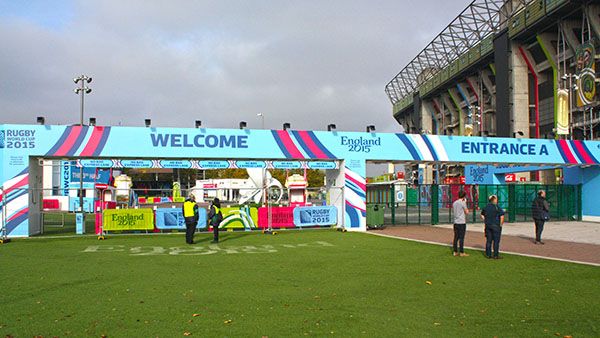The key objectives for delivering a successful transport operation for any stadium are to ensure that all client groups and all spectators can travel to and from the venue safely and efficiently, whilst minimising the impact on surrounding residents and businesses.
Spectators attending matches at any stadium exhibit behavioural patterns that reflect their familiarity with the venue. Home fans typically travel the same way, by the same mode for matches that are regular occurrences. Even visitors to Twickenham Stadium for annual Six Nations matches are fairly predictable in their behaviour; arriving at familiar stations, visiting favourite bars and taking their seat as late as possible.
The 2015 Rugby World Cup created a new spectator dynamic and transport demand as visitors from all the over world made the journey to Twickenham Stadium. As well as a major increase in visitors, match kick-off times were moved to 8pm to suit the television audience and additional media and hospitality requirements meant that car parking and operational space was considerably reduced.
The different event dynamics and crowd demographics highlighted the need for a significantly different transport operation at Twickenham.
RWC organisers built additional hospitality provision on top of existing stadium car parks. This meant more revenue but no parking. The displaced vehicles needed an alternative location so Steer Davies Gleave designed and operated two Park and Ride schemes at Kempton Park Race course and Hounslow Civic Centre.
As the Official Transport Planners, Steer Davies Gleave developed a bespoke spectator demand forecasting tool (TRACME) to predict shortfalls in transport capacity at the stadium. We used this forecast to establish a revised transport operation at the venue that created additional public transport capacity.
We also created a Wide Area Traffic Management Plan that managed existing and displaced traffic volumes. This new enhanced Venue Transport Strategy was designed to ensure that:
- Spectators could access and leave the stadium in good time and safely without impacting upon the access for teams, officials, VIPs or media;
- A reliable journey time could be achieved for all tournament officials and players so that scheduling of transport would be accurate and avoid impact upon pre-match preparation;
- Minimal inconvenience would be caused to local residents, businesses and background users;
- Match day operations remained unaffected by overlay changes, security screening, revised gate line location and amended traffic management plans.
The above aims are consistent service level requirements for stadiums across the globe, and these lessons learnt from Twickenham could be applied to the benefit of the stadium operators.
Despite the revised spectator demographics during the Rugby World Cup, the transport operation put in place worked for all functional areas. Therefore, it becomes interesting for stadium operators everywhere to question their existing provision of space and ask questions of their current operation:
- At Twickenham, SDG developed a plan that substituted existing on site car parking with additional public transport capacity. Therefore, what benefit does having on site car parking bring to the stadium? Could it be better utilised as concession and hospitality space with transport operations relocated off-site to a less premium location?
SDG understand venue transport and can identify ways to free up premium operational space to increase revenue generation for the stadium operator.
- Could the revised operation at Twickenham have implications for new stadium builds? Land purchase is a major part of development costs for a new stadium. Up to 50% of land purchase costs can be needed to create car parking and servicing areas. Is this efficient?
Involving SDG in the conceptual planning stages of a stadium build can save money by integrating the transport operation into the stadium design. Cutting down the amount of parking required on site, can create valuable revenue streams for public transport providers and host cities.
- At Twickenham we relocated on-site car parking to remote park and ride sites and designed a dedicated VIP parking area. On-site stadium car parks for spectators can lead to long delays to VIPs and key client groups as drivers struggle to merge into spectator traffic.
Steer Davies Gleave is experienced in putting in match day operations that provide express egress for key clients. By placing increased emphasis on organised public transport for general admission spectators and match day traffic management plans that recognise the differences between event, background and accredited vehicles, a more efficient access / egress plan can be achieved.
Written by Simon Hall

